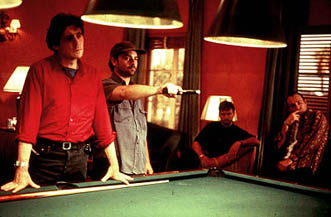Viking Night: The Usual Suspects
By Bruce Hall
December 7, 2010
Unable to believe that a master criminal like Keaton is truly dead, Kujan makes Verbal tell the whole story from the top, and the audience is taken along in the form of flashbacks, from Verbal’s perspective. His four accomplices are a motley assortment of conflicting personalities and complimentary talent, but it begins to seem as though they were too smart for their own good, as each time they work together they find themselves drawn deeper into the bowels of the criminal underworld, culminating in the fatal incident at the harbor. It becomes obvious that Verbal is hiding something, and when the other survivor from the boat awakens, he mentions a shadowy crime lord named Keyser Söze, whom he claims was behind everything. Kujan confronts Verbal, who is forced to admit that he was afraid to mention Söze for fear of reprisal. According to Verbal, Keyser Söze is a criminal genius whose legend is so powerful, whose reach so vast and whose wrath so terrible that his name is only spoken in hushed whispers even by the most hardened killers. No one has seen him, no one knows who or where he is, and nobody who has crossed him has ever lived. Kujan is forced to decide whether Söze is real and Verbal is telling the truth, or whether Verbal has simply concocted a cover story to buy time for Keaton to escape.
If this sounds complicated, it is and it isn’t. One of the most common complaints levied against The Usual Suspects is the complex plot. I’ll admit that I was never able to entirely follow it myself until I finally decided to grab a pen and take some notes. It reminds me of the noir classic The Big Sleep, whose story is so confusing that the author who wrote it famously remarked that even he wasn’t sure who the killer was. But while The Big Sleep is a literary train wreck, The Usual Suspects does make sense on paper, for the most part. But as with any great noir, the joy is less in the solving of the crime as it is in the journey and in the Payoff at the end. The Big Sleep is usually excused from making sense due to the fact that the dialogue crackles, the characters jump off the screen and the Payoff is that Bogart and Bacall are electrifying as they toy with each other and eventually come together at the end. The Usual Suspects is similar in that each of the leads is ideally cast – they commit to their performances, they clearly enjoy working together and the dense, wordy script is so fiendishly clever that you almost don’t care how it all turns out, just as long as it keeps going. And when the Payoff comes – when we discover the truth about Keaton and Keyser Söze – the moment is almost as chilling as Rosebud, almost as obvious in retrospect as “I See Dead People.”
If it’s true that the devil you don’t see is the one you should fear, it is equally true that should you happen to see him, he isn’t likely to be what you expected. And in this case, the surprise is well worth the ride.
I am not the sort of person who likes to try and figure out a complex movie while I am watching it. For me, trying to be smarter than the film tends to distract me from actually watching it, meaning that I miss more than I learn. But this is the kind of film that makes you want to decode it, and the “aha” moment at the end is so satisfying because you were sure you had everything all figured out, but in your heart you knew you were going to be wrong. My suggestion is to just let it happen – even once you know the ending, upon successive viewings you still find yourself noticing things that you didn’t see before, and it makes each time almost like a new experience. I’m not saying the plot doesn’t have holes – trust me, it does. But to discuss them would be to spoil the whole movie so if you haven’t seen The Usual Suspects, I highly recommend that you do and if you already have, you should watch it again. But don’t try to follow the story so much as let the story lead you. If you’ve ever taken a trip on a train, you know that the best thing about it is simply staring out the window, letting the scenery draw you in and the thrill of the experience envelop you. Only then can you understand how cool it is to ride a train. To do anything different would be to miss the point entirely.
Continued:
1
2
|
|
|
|




